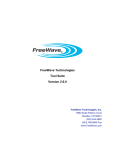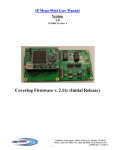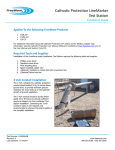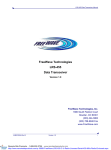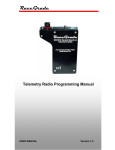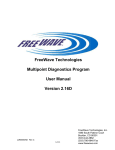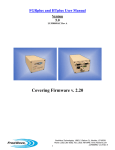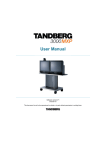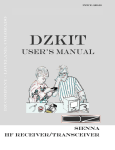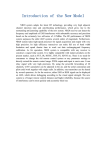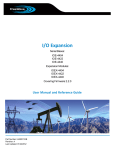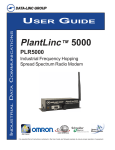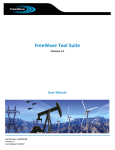Download Installing FreeWave Tool Suite
Transcript
FreeWave Technologies Tool Suite Version 2.4.0 FreeWave Technologies, Inc. 1880 South Flatiron Court Boulder, CO 80301 (303) 444-3862 (303) 786-9948 Fax www.FreeWave.com FreeWave Tool Suite Table of Contents INTRODUCTION........................................................................................................................................................ 3 INSTALLING FREEWAVE TOOL SUITE ............................................................................................................. 3 SOFTWARE SETUP ....................................................................................................................................................... 3 UPGRADING TOOL SUITE (FROM VERSIONS 2.0.1.2 AND BELOW) .............................................................................. 10 CONNECTING RADIOS TO A COMPUTER OR LAPTOP............................................................................... 12 RECOMMENDED COMPUTER DISPLAY SETTINGS ..................................................................................... 12 NAVIGATING THROUGH TOOL SUITE ............................................................................................................ 12 TOOL SUITE RIBBONS AND TOOLBARS ..................................................................................................................... 12 “FILE” BUTTON......................................................................................................................................................... 13 RIBBON TOGGLE BUTTONS ....................................................................................................................................... 13 USING TOOL SUITE SOFTWARE........................................................................................................................ 14 APPLICATIONS .......................................................................................................................................................... 14 ADDING A NETWORK ................................................................................................................................................ 14 Configuration ....................................................................................................................................................... 16 Radios .................................................................................................................................................................................16 Network Options .................................................................................................................................................................17 Filter....................................................................................................................................................................................19 Individual Radio Options ....................................................................................................................................................19 Upgrading Firmware ...........................................................................................................................................................20 Radio Information ...............................................................................................................................................................21 Operation Mode ..................................................................................................................................................................23 Baud Rate............................................................................................................................................................................23 Call Book ............................................................................................................................................................................24 Radio Transmission Characteristics ....................................................................................................................................24 MultiPoint Parameters.........................................................................................................................................................24 Templates............................................................................................................................................................................25 Network Diagnostics ............................................................................................................................................ 33 Networks.............................................................................................................................................................................33 Path View............................................................................................................................................................................38 Network Diagnostics Options .............................................................................................................................................38 Start a Diagnostic ................................................................................................................................................................49 Additional Feature...............................................................................................................................................................60 Local Diagnostics ................................................................................................................................................ 61 Spectrum Tool ...................................................................................................................................................... 63 Setup Terminal ..................................................................................................................................................... 65 Updates ................................................................................................................................................................ 66 Updating Tool Suite upon Program Start-up.......................................................................................................................66 Updating Tool Suite from an Open Session ........................................................................................................................67 Updating Tool Suite Locally ...............................................................................................................................................69 TECHNICAL SUPPORT.......................................................................................................................................... 71 2 FreeWave Tool Suite Introduction Tool Suite is a program that provides easy, reliable, and repeatable programming for FreeWave Technologies’ wireless data transceivers. The following FreeWave radios are compatible with Tool Suite: FGR2 IO Slave Board Level & Enclosed 2.4GHz I2-IO Board Level FGRIO Slave LRS 1.4GHz FGR 900MHz Series LRS 455MHz FGR 900MHz Short Range LRS 760MHz FGR2 900MHz Series SMR 3.4 GHz HTplus Board Level & Enclosed (Diagnostics only) HT 900MHz Series FGRIO Master IM 2.4GHz Series FGR Cathodic Protection MM2 900MHz Series IM 2.4GHz Cathodic Protection FGRplus Board Level and Enclosed (Diagnostics only) Ranger Series SSR 869 MHz Series 1.3GHz P-Series DGR 900MHz (Slaves) (Diagnostics only) 2.4GHz I2 Series Depending on the radio type, a radio may be configured via EZ Config, Hyperterminal or FreeWave Tool Suite. This document will describe how to configure radios and run diagnostics using FreeWave Tool Suite. Installing FreeWave Tool Suite NOTE: Microsoft .NET framework version 3.5, Microsoft SQL Server, and Windows XP SP2, Windows 2003 SP1, Windows Vista or higher are required for use of the Tool Suite. To install Tool Suite, download the file from the FreeWave customer extranet at http://www.freewave.com/customers/login.aspx, or use the FreeWave Utilities CD that comes with the radio. This process may include installing the .Net Framework and Microsoft SQL Server. NOTE: If the user does not currently have access to the FreeWave customer extranet, please contact FreeWave Tech Support at 303.381.9200 or 1.866.923.6168 to obtain a Customer Login. If .NET, Microsoft SQL Server and Microsoft Report Viewer 2008 are not already installed on the computer Tool Suite will run on, the user will be required to have an available internet connection during Tool Suite installation as .NET Framework, SQL Server and Report Viewer will be downloaded and installed automatically, before the Tool Suite software is installed. Software Setup 1. If the user is installing Tool Suite from the FreeWave customer extranet, double click “ToolSuiteWebInstall” or from the CD double click “ToolSuiteCDInstall” to install FreeWave Tool Suite. 3 FreeWave Tool Suite 2. If the user is upgrading an earlier version of Tool Suite, skip to the section “Upgrading Tool Suite.” 3. For users who do not have .NET Framework, Microsoft SQL Server, or Microsoft Report Viewer already installed on the computer Tool Suite will be used on, these programs will be installed first before the FreeWave Tool Suite software can initialize setup and be installed. 4. After opening the installer, click “Next” to setup Microsoft SQL Server Compact. a. After reading the “License Agreement,” in order to proceed, the user must accept the terms of the license agreement, then click “Next,” or “Cancel” to exit. b. Once the setup is complete, proceed to install Microsoft SQL Server Compact by clicking “Install.” Otherwise, select “Back” to return to the license agreement, or “Cancel” to exit. 4 FreeWave Tool Suite c. Once the user has received confirmation that Microsoft SQL Server Compact has installed successfully, click “Finish” to exit and proceed to the next installation. 5. Next, the user will install Microsoft .NET Framework. a. After reading the “License Agreement,” in order to proceed, the user must accept the terms of the agreement, then click “Install.” To exit, click “Cancel.” NOTE: the installer will first download then install Microsoft .NET Framework. This process may take several minutes. 5 FreeWave Tool Suite b. Once the user has received confirmation that Microsoft .NET Framework has installed successfully, click “Exit” to proceed to the Microsoft Report Viewer installation. 6. The user will now setup and install Microsoft Report Viewer. a. Click “Next” to proceed to setup or “Cancel” to exit. 6 FreeWave Tool Suite b. After reading the “License Agreement,” in order to proceed, the user must accept the terms of the agreement, then click “Install.” To exit, click “Cancel.” c. Once the user has received confirmation that Microsoft .NET Framework has installed successfully, click “Finish” to proceed to the FreeWave Tool Suite installation. 7 FreeWave Tool Suite 7. Finally, the user will setup and install FreeWave Tool Suite. a. Click “Next” to continue or “Cancel” to exit. b. To proceed, the user will need to choose the setup type. NOTE: Currently “Typical” and “Complete” are the same install. 8 FreeWave Tool Suite c. Once the user has received confirmation that Tool Suite is ready to install, click “Install” to proceed to the installation process, otherwise click “Back” to review or change installation settings or “Cancel” to exit. d. The install program will confirm the successful installation of the Tool Suite. Click “Finish” to exit and launch FreeWave Tool Suite. 9 FreeWave Tool Suite 8. A FreeWave Tool Suite icon has been added to the computer’s desktop. Upgrading Tool Suite (from versions 2.0.1.2 and below) If the user is upgrading from a previous version of Tool Suite, the following steps are required: 1. Select the “Updates” button. 2. A prompt that “New updates are now available, would you like to download” will appear. Select “Yes.” 3. Once the update has been downloaded, the user will be prompted to install the updates. Click “OK.” 4. Another prompt will appear asking the user if they would like to merge databases. NOTE: Tool Suite databases from versions 2.0.1.2 and below are not compatible with Tool Suite version 2.2’s database. Merging formats the earlier database versions for use with version 2.2 and above. 10 FreeWave Tool Suite 5. To merge databases, click “Yes.” If this is not desired, click “No,” (all previously saved data will be lost) or “Cancel” to exit setup. 6. If the user merges the database, a status box will appear while the databases are being merged. Please be advised, this can take several minutes to complete. If the user does not merge databases, Tool Suite will restart automatically upon clicking “No.” 7. Once the merge is complete, Tool Suite will reload and then restart automatically. NOTE: Tool Suite versions 1.4.1 and below cannot be upgraded from the “Updates” Application. To upgrade to the latest (2.2 or above) version of Tool Suite, the user will need to first un-install Tool Suite, and then download the latest installer from the FreeWave customer extranet or Utilities CD. Then refer to step 7 under “Software Setup” to install the Tool Suite software only. 11 FreeWave Tool Suite Connecting Radios to a Computer or Laptop Connect a serial or diagnostic cable between the computer or laptop and the radio. A diagnostic cable is recommended. Plug in the power supply and turn on all radios. NOTE: A serial cable can be used for both Configuration and Setup Terminal functionality, but in order to run diagnostics using the Network or Local Diagnostics Applications, a diagnostic cable must be used. Also, for diagnostics only, functionality is available via TCP/IP if routing through a Terminal server to reach the serial master radio. Recommended Computer Display Settings In order to achieve optimal visual performance from Tool Suite, it is recommended that the user set the computer’s desktop display settings accordingly: NOTE: Administrative rights to the computer may be required to make the following changes. To verify if the user has rights, please contact your IT Department. • Minimum resolution set to: 1024 x 768 (higher resolutions would serve the user better) • DPI set to: 96 NOTE: A DPI setting of 120 is not supported (graphics may not line up and text may be partially hidden). Navigating through Tool Suite To configure radios, start/stop diagnostics, and other functions, the user can navigate through Tool Suite using the buttons on “ribbons” and “toolbars” and the right- and left-click buttons on a mouse. Tool Suite Ribbons and Toolbars Ribbons refer to the toolbars that either have the FreeWave logo on them or the title bars just below that display the network name. The button sections found on these ribbons are specific to the Application the user is working in. Below the main ribbon is a “Network” title ribbon that displays the name of the network that is currently in use. This ribbon is only displayed in the Configuration and Network Diagnostics Applications. Configuration view of the title ribbon: Network Diagnostics view of the title ribbon: 12 FreeWave Tool Suite “File” Button There is a “File” button, which functions similar to a “File” drop-down found in most software programs, that contains: 1. Hide Applications: Allows the user to hide or show the Applications window pane. 2. Help: a. About: Displays version information of the Tool Suite software b. User Manual: Opens an Adobe PDF version of the latest Tool Suite user manual (Adobe Acrobat Reader is needed to view this file) 3. Exit: The user can choose to exit the Tool Suite program from this menu (or by clicking the “X” on the title bar) Ribbon Toggle Buttons Located above the “File” button, is a small drop-down button that allows the user to: 1. Hide or show the ribbon toolbar (Minimize the Ribbon) 2. Move the drop-down button to its own toolbar, which displays below the ribbon, or replace the drop-down button back to its original position above the “File” button on the title bar. (Show Below the Ribbon) This function can also be achieved by hitting the ribbon toggle button located above the FreeWave logo. NOTE: To view the ribbon while it is hidden, click the tab that displays the application name. The ribbon display will be restored once you change to another Application or hit the toggle button above the FreeWave logo. 13 FreeWave Tool Suite Using Tool Suite Software Applications To launch a Tool Suite Application, double click the FreeWave Tool Suite icon on the desktop, if the software is not already open. The software will launch displaying the applications available. 1. Configuration 2. Network Diagnostics 3. Local Diagnostics 4. Spectrum Tool 5. Setup Terminal 6. Updates Adding a Network The user should name and setup a network prior to configuring radios or running diagnostics for the first time with Tool Suite. Multiple networks can be added to Tool Suite. Once multiple networks are setup they can run simultaneously as well. 1. When launching Tool Suite for the first time, the network name defaults to “Default Network”. The user can edit this network name and settings or delete this network and create a new one. 2. To add a new network in Configuration, click “Add Network” in the “Datastore” section of the Configuration ribbon 3. Enter a name for the network and then click “Next.” 14 FreeWave Tool Suite 4. Click “Finish” to save the network name and return to Configuration. 5. To add a new network in the Network Diagnostics view, please visit the section on Network Diagnostics. 15 FreeWave Tool Suite Configuration Configuration allows the user to setup their radio according to their network requirements. 1. To begin configuring radios, select “Configuration” from the Applications pane. 2. In the Configuration view, select the appropriate Com Port. NOTE: Tool Suite will provide a list of available Com Ports. To find the correct Com Port on your computer or laptop, follow the path: Control Panel →System→Hardware→Device Manager→Ports. 3. Once the appropriate Com Port has been selected, click the “Read Radio” button to import settings from the radio that is currently connected to the serial or diagnostic cable. NOTE: Tool Suite does not automatically read settings from radios. Radios Database Functionality FreeWave Tool Suite maintains a database of all radios that have been read, programmed, or otherwise manipulated through the program. This database has many functions that allow the user to check settings without being connected to the radio. 16 FreeWave Tool Suite Network Options The Radios tab displays a tree view of radios in the database (whether they have been configured through Tool Suite, or added through Network Diagnostics). Right-clicking on “Network”, displays a list of options. NOTE: The same options are also available by right-clicking in the blank area of the window pane, or by clicking on the “Options” drop-down located on the Configuration network title ribbon. Add Folder The Add Folder option allows the creation of a folder in which to store specific radios. This is useful when the user manages several networks as it allows organization of files by network. Add Radio The Add Radio option allows a user to manually name and add a radio to the network window pane. This feature functions as a single radio template. Import The Import function allows a user to import network or individual radio database settings from different file formats: 17 FreeWave Tool Suite 1. A complete network from either an earlier Tool Suite database (.sdf file extension) or from the current database (.fwn file extension) 2. An import from an existing EZ Config file (.fws) into Tool Suite. This allows the user to rapidly upgrade from Legacy EZ Config setup files to the Tool Suite database. 3. Tool Suite also allows a user to import settings from a similar radio type to another. For example, if the user has an FGR 900MHz radio “Slave” file that can be used as a “template” to setup other radios similarly, the user can connect to an FGR2 900MHz radio, and then import the FGR file to setup the FGR2 with the same settings. This is useful if the user has a mix of radio types in a single network that will use the same frequency key, network ID, and other settings that need to be identical throughout the network. 4. Template files can also be imported (.fwt). See the Template section to learn more about how to use this new feature. NOTE: A Tool Suite version 2.2 and above file type (.fwn) can also be imported by clicking “Import Network” in the Datastore section on the Configuration ribbon. Export The Export function allows a user to save the entire network of radios and then transfer that information to a different computer or instance. The file created may be copied and imported into other instances of Tool Suite. The user can also export Template files. Refresh The Refresh function updates the radios in the network. If you are running diagnostics, but did not need to configure them in Configuration and radios are not shown in the Radio List in Configuration, the user can right-click on the network, select Refresh, and the radios should populate in the list. Clear Network With this function the user can clear the list of all radios shown in the window pane. NOTE: All radio configurations will be lost if Clear Network is selected. Remove Network This function permanently deletes all the radios and network settings, as well as the network name and data. 18 FreeWave Tool Suite Filter Located next to the Options drop-down on the Configuration title ribbon, Filter displays radios that only meet the modem mode criteria a user specifies. Individual Radio Options Specific options for a radio can be found by right-clicking on a radio in the window pane. View Report The View Report function creates a document that displays all of the settings in the radio. This document can be saved in either Microsoft Excel or as a PDF. It can also be printed. Export Unlike the Datastore export function, the radio export function allows the user to create an individual radio database file that can be copied and then imported into any other instance of the Tool Suite by exporting only the selected radio. Delete 19 FreeWave Tool Suite The Delete function removes the highlighted radio and all information related to that radio from the database. Upgrading Firmware Tool Suite allows the user to upgrade firmware locally. NOTE: Currently Tool Suite does not support over-the-air firmware upgrades. Also, if an older version of firmware is loaded that is not supported by Tool Suite the software will prompt the user to launch EZ Config to run the configuration. 1. To check the current firmware version loaded on the radios in a network against a current firmware list, click “View Available,” in the firmware section in the Configuration ribbon. 2. This will display a list of the latest firmware versions for Tool Suite supported products. 3. Available settings for a Model are also given for viewing. 4. To upgrade to the latest firmware, connect to the desired radio for upgrading and then click “Upgrade.” 20 FreeWave Tool Suite 5. A prompt asking the user if they would like to continue will appear. Click “Yes,” to proceed, or “No” to cancel. 6. Tool Suite will identify and display the firmware version that is loaded on the connected radio and then display the latest version of firmware available for that model. To proceed with the upgrade, click “Yes,” or click “No” to exit. 7. A status of the firmware upgrade will appear. Once complete, a dialogue box informing the user that the firmware upgrade was successful should appear. Radio Information Upon a successful read from the radio (after clicking on “Read Radio”), the “Radio” list will be updated to include the radio serial number, radio name, and a symbol to indicate the operation mode. The Tool Suite will refresh the right side of the window displaying the settings of the radio. 21 FreeWave Tool Suite All current settings from the radio are then stored in the database of Tool Suite. These settings may be viewed by highlighting the serial number of the radio and then navigating through the Menu Tabs located in the tab bar on the right side of the screen. The tabs are labeled by menu name, and correspond to the menus as they appear in HyperTerminal. Imported radio settings may be adjusted to individual requirements. Hovering the mouse pointer over a setting displays a brief description of what it does. After the desired changes have been made, click “Program All” to apply settings to the radio. If only a few settings have been changed, the “Program Quick” option can be useful and less time consuming. The “Program Quick” option should only be used if the current settings have been read from the radio. If the user desires to set a radio or radios back to factory defaults, simply click on the “Default” button, which will prompt the user if they wish to proceed. 22 FreeWave Tool Suite NOTE: Until “Program All” or “Program Quick” has been selected, the changes made to settings in Tool Suite will not be sent to the radio; this includes when setting a radio back to factory defaults. Operation Mode Operation Mode defines the transceiver function (Master, Repeater, Slave, etc). FreeWave transceivers operate in a Master to Slave configuration. Before the transceivers can operate together, they must be set up to properly communicate. Ethernet options are also configured in this tab. Please refer to the user manual for each specified radio type in your network for setting requirements. Baud Rate This menu allows the user to set the communication rate between the transceiver and the instrument to which it is connected. 23 FreeWave Tool Suite Call Book The Call Book allows users to incorporate up to 10 FreeWave transceivers, designate 1 to 4 Repeaters to be used with each transceiver, and designate which Slave the Master will call. The Call Book is required to be used in Point-to-Point networks. While the Call Book is an option in Pointto-MultiPoint networks, the Network ID feature is strongly recommended in most applications. Radio Transmission Characteristics The Transmission Characteristics allows the user to modify several different parameters in the transceiver. Many of these parameters must be maintained throughout the network for proper functionality. NOTE: This menu determines the RF characteristics used by the radio network. Default settings are not recommended for the network critical settings. However, an understanding of the settings in this menu is recommended prior to changing any of the values. MultiPoint Parameters MultiPoint Parameters consist of settings used to control how data is handled in situations requiring retries and the settings to control the behavior of a MulitPoint slave or repeater. 24 FreeWave Tool Suite When installing MultiPoint networks it is important to do some initial planning. Unlike Point-to-Point networks, a Point-to-MultiPoint network requires several parameters to be set consistently on all transceivers in the network. This includes RF data rate, Min and Max Packet Size, and FreqKey. For detailed information concerning radio parameters, please refer to the appropriate Spread Spectrum Wireless Data Transceiver User Manual. Templates The Template feature allows a user to design and configure a network PRIOR to programming radios. This feature can even be utilized without previously adding radios to the Network through the “Configuration” tab. Upon the first initial opening of the “Templates” tab, Tool Suite will prompt the user to add a Master radio using the Template Wizard. 1. From the drop-down list, choose the Master radio type and then click “Next. 2. When prompted to select the network structure, click “Next.” 25 FreeWave Tool Suite NOTE: As of Tool Suite release version 2.4.0, Point to Point and TDMA network structures are not yet supported in the Templates feature. 3. For FreeWave radios to successfully communicate with one another within a network there are 5 key settings that must be the same across all radios in the network. When prompted, set the following to the desired values: a. Frequency Key: Values available to choose from are numbers 0 through 9 and letters A through E b. Max Packet Size: Choose from numbers 0 through 9. c. Min Packet Size: Choose from numbers 0 through 9. d. Network ID: Values available to choose from are numbers 1 through 4095, except 255. e. RF Data Rate: Choose either Normal or High. NOTE: For more information regarding radio settings, please refer to the appropriate FreeWave user manual for the radio type. 26 FreeWave Tool Suite 4. Next the user will configure data port settings, which will be inherited by any Slaves, Repeaters, or Slave/Repeaters the user connects to this Master template. 5. Lastly, if desired, the user may give the template a name. Click “Finish” to save the template. 6. Once the initial creation of the Master radio template is complete, a Master radio icon will appear under the template tab with the network parameters selected by the user. 27 FreeWave Tool Suite Connecting Slave, Repeater, and Slave/Repeater Radios to a Master Template Once the user has created a template for a Master radio, the next step is to virtually connect Slaves, Repeaters, and/or Slave/Repeaters for programming. 1. Right-click on the Master Template, select “Connect,” and then choose whether the connected radio will be a: a. Slave: Once “connected,” an icon for the Slave will appear with its settings below b. Repeater: Once “connected,” an icon for the Repeater will appear with its settings below 28 FreeWave Tool Suite c. Slave/Repeater: Once “connected,” an icon for the Slave/Repeater will appear with its settings below NOTE: Not all radio product types support Slave/Repeater functionality. Please refer to the appropriate FreeWave user manual for information on what is supported for the selected radio type. 2. To connect another radio to the Master, a Slave, Repeater, or Slave/Repeater, right-click on the radio the user wishes to add a connection to and repeat the steps to add a Slave, Repeater or Slave/Repeater connection. Edit Settings for Template Radios The user may view and change all other settings that were not addressed during the wizard and are available under the Radio tab in Configuration. (For example, the user can change Ethernet settings in Operational Mode, Baud Rate Settings, etc.) 1. Right-click on the radio the user desires to change the settings on, to access the setting menu tabs. 29 FreeWave Tool Suite 2. After the desired changes are made, click “Update” to save the settings or “Cancel” to exit without saving any changes. 3. Tool Suite will prompt the user to select whether the settings changes will affect just the selected radio or all the radios in the “virtual” network. Click “Yes,” to apply the changes to all connected radios in the template, “No,” for just the selected radio, or “Cancel” to return to the “Edit Settings” screen. 4. Tool Suite will refresh the templates with the change and then return the user back to the template screen. Program Radios with Template Settings Once the “virtual” network is designed, the user will need to program each radio individually to capture the settings. 30 FreeWave Tool Suite 1. Starting with the Master, make sure the serial or diagnostic cable is connected to the radio that will be programmed. 2. Right-click on the Master, or subsequent template, for programming and select “Program Settings.” 3. When Tool Suite prompts the user to name the radio, either enter a name and click “Program,” or leave the field blank and press “Program.” Otherwise, select “Cancel” to exit without programming the radio. 4. A status bar will appear while the radio is being programmed. Once the programming is complete, Tool Suite will return the user to the Template page. For each subsequent radio in the network that needs to be programmed from a template, connect the serial or diagnostic cable to the radio for programming and repeat steps 2 and 3 in this section. Rename a Radio Template 1. To change the displayed name of a template, right-click on the template the user wishes to change and select “Rename.” 31 FreeWave Tool Suite 2. After changing the name, select “Update” to save the change, or “Cancel” to exit without making any changes. 3. Tool Suite will prompt the user to verify the change. Select “Yes” to proceed with the change or “No” to exit and close out without making a change. 4. Once Tool Suite has updated the database, the user will be returned to the Template screen. Remove a Radio Template The user is able to delete a group of radio templates or a single radio template that is an end-point. For example, by removing the Master or a Repeater, all connected radios will be deleted as well, and by removing a Slave that is at the end of a network, only that Slave is deleted. 1. To remove a template or templates, right-click the radio template to delete and select “Remove.” 2. The user will be prompted to select “Yes” to proceed or “No” to cancel without deleting the template(s). 3. The template(s) removed will no longer be shown in the Template diagram. 32 FreeWave Tool Suite Network Diagnostics Network Diagnostics permits setup of different types of diagnostic networks and to view diagnostic data in real time. Click “Network Diagnostics” in the Applications pane to get started. Networks Add a Network If a network was added through Configuration and the user would like to setup or modify network settings, located on the network title bar, click the “Options” drop-down and select “Network Settings.” NOTE: Refer to Network Settings on page 41 for assistance on setting up or modifying network settings. The “Add” button creates a new set of data including a new Master, Repeaters (if applicable) and Slaves. On the Network Diagnostics ribbon, under “Networks,” click the “Add” button to add a new network. The Network Diagnostics Configuration Wizard will launch and walk through the setup process. Enter a name in the Network Name box, and click “Next”. 33 FreeWave Tool Suite Serial Network 1. Select the Network Type: Serial, TCP Terminal Server or Plus Ethernet. If you are using the Serial option (which is most commonly used) Click “Next.” For TCP Terminal Server setup, see page 37 and for Plus Ethernet setup, see page 39. 2. If 1.4GHz radios are used, this needs to be specified. Select “Yes” when prompted. 34 FreeWave Tool Suite 3. For all Master radio types: Select the Com Port you are using and then click “Next.” 4. Click “Finish” to save the network and return to Network Diagnostics, or “Back” to make changes or to cancel and exit the wizard. 5. The new network will appear in a list at the top of the page in the “Current Network” box and on the network title bar. 6. To add additional networks, click “Add,” and repeat the setup steps through the wizard for each new network. TCP Terminal Network 1. Select “TCP Terminal Server” and select “Next.” 35 FreeWave Tool Suite 2. Enter the IP Address and the Port number of the radio which you are using. Select “Next.” 3. Once all the required settings have been entered click “Finish” to save the network to the database. 36 FreeWave Tool Suite 4. The new network will appear in a list at the top of the page in the “Current Network” box and on the network title bar. 5. To add additional networks, click “Add,” and repeat the setup steps through the wizard for each new network. Plus Ethernet Network 1. Select “Plus Ethernet,” and click “Next.” 2. Once all the required settings have been entered click “Finish” to save the network to the database. 37 FreeWave Tool Suite 3. The new network will appear in a list at the top of the page in the “Current Network” box and on the network title bar. 4. To add additional networks, click “Add,” and repeat the setup steps through the wizard for each new network. Path View When the Network Diagnostics application is opened, radios will populate under the path view showing the user a Master/Repeater/Slave radio hierarchy. Check Boxes Checked radios get actively polled and radios that are unchecked are excluded from polling. NOTE: All related radios linked to a Master will become checked or unchecked by clicking the Master. Ctrl + left-click checks or un-checks a single radio. Radio Icon Legends M Icon: This icon stands for Master radio and when it is blue, either there are no alarms/warnings, or all alarms/warnings have been acknowledged or cleared for this radio. S Icon: This icon stands for the Slave radio and when it is blue, either there are no alarms/warnings, or all alarms/warnings have been acknowledged or cleared. R Icon: This icon stands for Repeater and when it is blue, either there are no alarms/warnings, or all alarms/warnings have been acknowledged or cleared. S/R Icon: This icon stands for Slave/Repeater and when it is blue, either there are no alarms/warnings, or all alarms/warnings have been acknowledged or cleared. The Path View tab displays a tree view of radios in the network, whether they were added manually or through a discovery feature. Under the Path View tab, the user can access Diagnostics, Settings, Alerts and History specific to a selected radio. Network Diagnostics Options The “Options” button is located on the Network Diagnostics title ribbon. Several Network Diagnostics features are accessed through “Options.” Serial Network Diagnostics Options: 38 FreeWave Tool Suite Plus Ethernet Network Diagnostics Options: Network Settings Displays the current configuration of a network, which the user can edit. Name The user may define a network name. This field defaults to “Default Network” if a name is not chosen when creating a new network. Interface Allows the user to change the network type, COM port, or whether 1.4GHz radios are in use. If the user makes changes in the section, be sure to click “Update” to save the changes, or “Cancel” to exit without saving any changes. 39 FreeWave Tool Suite Polling Interval The user may change the speed the radios are polled. This field defaults to 200ms for Serial and TCP/IP networks, and defaults to 500ms for Plus Ethernet networks. The chart below illustrates recommended polling intervals based on whether serial Repeaters are used in a network or not. Network Type Default Polling Interval Minimum Polling Interval Repeaters turned OFF in Master 1 Repeater (add 50ms) 2 Repeaters (add another 50ms) For each addt’l repeater, continue to add 50ms… Serial 200ms 100ms 100ms 150ms 200ms 250ms TCP/IP 200ms 100ms 100ms 150ms 200ms 250ms Plus* 500ms 100ms 100ms 150ms 200ms 250ms 455MHz 200ms 300ms 300ms 600ms 600ms Not supported NOTE: *For Plus Ethernet networks: customer data is not given polling priority over diagnostic data. Polling Mode 1. Discovery: This is the default mode when a new network is added. Upon the first diagnostic run of a new network, to discover radios more quickly, set the polling mode to Discovery. This will allot 9 out of 10 polls to discovering new radios in the network, and 1 out of 10 polls to populating settings information. NOTE: “Discovery” mode is not available for Plus Ethernet networks. 2. Sequential: Once all radios have been discovered in the network, it is recommended to change to Sequential mode. This will allot 1 out of 10 polls to discovering new radios, and 9 out of 10 polls to populating settings information. Remove History Before This feature allows the user to delete historical data that is stored in the Tool Suite network database. When a user specifies a date for “Remove History Before,” Tool Suite will delete stored historical data starting on 1 day prior (the actual date for removal) to the date the user specified. Further, any data collected on or before the actual date will be deleted. 1. Enter a date 1 day before the actual date the user desires deletion to take place. 40 FreeWave Tool Suite In this example, Tool Suite will delete any stored data starting September 30, 2009 and before that date. 2. Select “Remove.” A prompt verifying the user wishes to continue should appear. 3. To proceed, click “Yes,” or to exit without deleting any data, click “No.” Notes This field may be useful for logging any additional information about the network that is not highlighted in the settings. After all desired changes are made, click ‘Update” to implement save the changes or “Cancel” to quit without saving. Poll Radio The user may poll an individual radio for discovery or settings. This feature is also available by rightclicking on an individual radio, and when in the “Settings” tab for Serial and TCP/IP networks, the user can poll the radio for a specific setting. NOTE: Tool Suite must be actively polling the network. This means the user has pressed “Start” and the Poller Status displays: “Connected.” If the user is not connected, an error message will appear. Click “OK” and make sure an active network is being polled. Polling Serial and TCP/IP Radios If Serial radios are not automatically discovered, or the settings have not populated, while polling an active network, the user can manually poll a single radio to discover it and/or the radio’s settings. The polled radio should appear in the Path View window pane if polling for discovery, and the setting should appear if polling for settings. The user may need to poll the radio more than once in order to discover it or populate its settings. 41 FreeWave Tool Suite Polling Plus Radios While polling an active Plus Ethernet network the user can manually poll a range of IP addresses the network spans to discover those radios. The polled radios should appear in the Path View window pane once discovered. The user may need to poll the IP addresses more than once. Discover Radios This feature is strictly for discovering Plus Ethernet radios. 1. Choose a length of time to automatically stop searching for radios. To stop searching before the allotted time, just hit the “Search” button again. 2. Once radios are discovered, hit “Add Radios.” To clear the radios listed, select “Clear.” 42 FreeWave Tool Suite 3. The radios should appear in the Path View. Populate Name/Firmware The Populate Name/Firmware feature allows a user to manually poll Plus Ethernet radios for these settings. NOTE: This feature is only available on Plus Ethernet networks using firmware versions 2.19 and above. Alerts The Alert function gives the ability to view and customize alert notification according to the user’s network requirements. 43 FreeWave Tool Suite Modify Alert Definitions Modify Alert Definitions is a function where the user can configure system event notifications either as a warning or as an alarm. NOTE: The network must be stopped before modifying alert definitions. An error message will appear if the user attempts to modify alerts while the network is active. If this occurs, click “OK,” “Stop” the poller and try again. View Alert Report Alert Report displays a list of all active acknowledged or unacknowledged alerts. The alert report is similar to the Radio information report. The Alert report can have a date range set, alert level specified, and saved either as an Excel or PDF file. 44 FreeWave Tool Suite Once the user completes reviewing the alerts report, exit out of the report and click “Cancel” on the Alerts Reporting dialogue box to exit. Acknowledge All Alerts Allows the user to check off any unacknowledged warnings or alarms for an entire network. Clear All Alerts Allows the user to clear all acknowledged and unacknowledged warnings and alarms for an entire network. Import The Import Network function allows the user to import network settings using the following file types: 1. Tool Suite – versions 2.2 and above (.fwn) 2. Tool Suite - versions 2.0.1.2 and below (.fdn) 3. Comm Control (.nwf) 4. Comma Separated Value (.csv) NOTE: Plus Ethernet networks only have the option to import Tool Suite .fwn and Comma Separated Value .csv file types. Click “Import” in the Options drop-down to import any of the network types listed above. 45 FreeWave Tool Suite NOTE: The “Import” button located on the main ribbon only imports Tool Suite version 2.2 and above file type (.fwn). Once the file has been imported Tool Suite will alert the user that the import was successful. NOTE: Comma Separated Values (.csv) files must be formatted “Serial Number,” “Name,” and if applicable, “IP Address.” If the Comma Separate Values (.csv) file is not in this format, an error message will appear. Export The Export Network function allows a user to export the network file, all radio settings, as well as the Path View window pane view and any historical data. Tool Suite can export a .fwn file or a .csv file. The polling service must be stopped to export data. 46 FreeWave Tool Suite The network the user wishes to export must be selected and displayed in the Network Diagnostics application. Start by clicking “Export” in the Options drop-down and choosing the file type to export. For Tool Suite .fwn files, choose the date range of the data to export, choose whether diagnostic history will be excluded or not, and select “Export” to save the file to a hard drive folder or “Cancel” to exit. Name and save the file to a desired location. The file will be exported as a .fwn file (Tool Suite versions 2.2 and higher). For .csv file exports, select “Export” from the Options drop-down and select Comma Separated Values. Name and save the file to a desired location. 47 FreeWave Tool Suite Once either a .fwn file or .csv file has been exported the system will alert that user that the export was successful. Clear Radios Removes all radios and settings from a network; however, the network name and network settings remain. Tool Suite will prompt the user before they clear a radio list. Click “Yes” to proceed, or “No” to cancel and exit. Remove Network Deletes all radio and network settings associated with a network, as well as the network name and any stored diagnostic data. Tool Suite will prompt the user before they remove an entire network. Click “Yes” to proceed, or “No” to cancel and exit. 48 FreeWave Tool Suite Start a Diagnostic Tool Suite no longer utilizes the Active and Inactive button functions. Instead, starting a network in the “Current Network” list “activates” it and stopping a network “inactivates” it. The user can run multiple networks at a time. NOTE: Please keep in mind that if multiple networks are running, this may greatly slow the performance of the computer. To speed up processing time the user may “Stop,” or inactivate, any networks that do not need to actively run at that time. Serial and TCP/IP Once the network is configured (Serial or TCP/IP) click “Start” to run the diagnostic network. The “Start” button will become greyed out when initialized. Radios will start to report in and populate in the Path View and the graph will begin to display diagnostic readings. There is a “Poller Status,” located at the very bottom of the window, which indicates if the poller is connected or disconnected. If the poller is connected, but no radios are being added to the Path View, double check that the diagnostic cable is connected to the Master radio. Plus Ethernet Once the network is configured, the user will need to discover radios before diagnostics can be run. 1. On the title ribbon, click the “Options,” drop-down, and select “Discover Radios…” Follow the steps in “Discover Radios” in the Options section of the manual. 49 FreeWave Tool Suite If returning to an existing Plus Ethernet network, click “Start” to run diagnostics. NOTE: Broadcasts may be blocked through certain brands of routers. If data is not displaying in Tool Suite and other factors have been ruled out, the user may try connecting the Ethernet cable directly to the computer’s or laptop’s Ethernet port. Diagnostics A graph will populate with communication information showing how the radio is functioning. This view presents several diagnostics statistics and values of the radios, which can be added or removed to or from the graph view by right clicking on the graph. Last Response Displays the date and time for the last time the radio responded to a poll. Missed Polls Tracks the number of missed polls a radio does not receive until a successful poll is logged. Once there is a successful poll, the Missed Polls number resets to zero. Data Sent Only available for Plus Ethernet networks, Data Sent keeps track of the increasing number of polls a radio has sent out. When running diagnostics on Serial radios, the Data Sent number will remain at zero. 50 FreeWave Tool Suite Reset Zoom Within the diagnostics graph the user has the ability to zoom into the diagnostics graph. Reset Zoom will restore the default zoom level. The user can reset to zoom by either clicking on the circles at the end on the scroll arrows or by right clicking on the graph and selecting reset zoom from a menu list. Zoom Functionality – By clicking on the graph a blue line axis will appear. Pull the lines to zoom to the desired value. Reset Zoom with Buttons Functionality – Click on both buttons highlighted to reset the zoom. Another option to reset zoom is to right click on the graph to get a list of functions. The first option is to “Reset Zoom.” 51 FreeWave Tool Suite Diagnostic Statistic Definitions and Recommended Values Inbound Signal/Noise: The inbound signal is the signal being received by the slave or repeater from the master or repeater that radio is linked to. The Inbound noise is the noise at the selected slave or repeater. Outbound Signal/Noise: The outbound signal is the signal being received by the master or repeater from the slave linked to it. The outbound noise is the noise that is seen at the Master or repeater. In/Out Margin: The margin is the difference between the signal and noise. In Margin is the spread of points between the Inbound Noise and Inbound Signal. We recommend a minimum of 20 dB. This means the signal needs to be 20dB higher than the noise. Out Margin is the spread of points between the Outbound Noise and Outbound Signal. A spread of 20dB or greater is considered ideal. Voltage: The voltage is the input voltage received by the radio. This value should be with in the specified range of the radio that is being read. Example: FGR series radio should be between the 6 and 30 Volts DC. Temperature: This is a reading of the temperature of the radio. VSWR: This setting is reporting the amount of signal being reflected back into the radio. A setting between 0 and 5 is considered good, between 6 and 25 is Fair, Between 26 and 30 or higher is considered Poor and needs attention. Receive %: Receive rate measures the percentage of data packets that were successfully transmitted from the Master to the Slave on the first attempt. A number of 75 or higher indicates a robust link that will provide very good performance even at high data transmission rates. A number of 15 or lower indicates a weak or marginal link that will provide lower data throughput. An Overall Receive Rate of 100% will provide approximately 100 KBaud of bandwidth with an RF Data Rate setting of 3 and approximately 150 KBaud of bandwidth with an RF Data Rate of 2. These numbers are reduced approximately 50% if one or more Repeaters are in the network. DiagPoll% (serial only): Poll is the diagnostics response rate. This is the percentage of the time that the radio reported back diagnostics data when polled. If the radio transmits a lot of data as part of its normal operation, it will have less time to respond to the Master polling it for diagnostics data; in that case, the diagnostics response rate will decrease. If this value is 0, it may be because this radio is disconnected from the network Transmit % (Ethernet only): The Transmit % is only used in the Plus series radios. This statistic shows the percentage of packets sent by the radio that successfully reached the upstream radio (i.e. the Gateway or a Repeater). This statistic will show '0.00%' on a Multipoint Gateway or Multipoint Repeater. This statistic is only valid on Multipoint Endpoint radios. FreeWave recommends a minimum of 75% for proper radio operation. 52 FreeWave Tool Suite Chart Span: Allows the user to select a specific span of time on the graph. Radio Summary View The Summary View, located next to the Path View tab, is a tabulated configuration summary of statistics of radios in the network. Information can be sorted by any column in the Summary View. NOTE: Summary information can be copied and pasted into an Excel spreadsheet by right-clicking an individual radio or right-clicking and selecting “select all” (or by Ctrl + a) and then copying and pasting the radio information from the Summary View into an Excel spreadsheet. Serial and TCP/IP Summary View: Plus Ethernet Summary View: Settings Tab There is a Settings tab located at the bottom of the Network Diagnostics page. This functionality allows the user to tab through each of the radio configuration fields and change information according to the radio’s requirements over-the-air. Operation Mode, Baud Rate, Transmission Characters and Multipoint Parameters are available to configure. 53 FreeWave Tool Suite When making changes, always start at the furthest site in the line, for example, the Slave radio furthest from the Master radio. In order to make a settings change over the air, the user must click on the Settings tab, select the desired setting to be changed and right click. A menu will appear allowing the user to Change Settings. Type in or choose from the drop-down list the desired setting and click “Change”. 54 FreeWave Tool Suite A screen will appear asking if the user would like to make the change. The next screen shows the progress of the change being made. A small warning icon will appear next to the setting that is being changed as well. The new value should show up after the warning symbol disappears. If the value does not show right away, the user may try polling the radio to make sure the setting was changed. The user may need to poll the radio multiple times. NOTE: This feature is not available for Plus Ethernet radios. To view and change settings for Plus Ethernet radios, the user can go to the Settings Tab and then click “View Configuration.” This will open a web browser and prompt the user to enter a user name and password to access the page. 55 FreeWave Tool Suite Alert Tab This tab displays a chart of alert values for an individual radio’s diagnostics. When an alert is logged on the system an indicator will illuminate next to the serial number of the radio in red or yellow, depending on the type of warning or alarm. To view a description of the alerts or alarm for a particular radio, click on the serial number then on the Alert tab at the bottom of the screen. To acknowledge an alert or alarm for a radio, click on the Acknowledge Alerts button and it will clear the indicator next to the serial number of the radio. Click Clear Alerts to clear alerts for the radio selected. If you clear the alerts, the warnings and alarms may return if the radio is still out of the set value range. The warnings or alarms will still be visible on the alerts page for later reference but the indicator next to the serial number will be clear. All warnings or alarms that have been acknowledged will have a check box on the far right side indicating that it has been acknowledged. For each value that is reported in diagnostics, there are set values which are warning and alarm values. A warning is when the radio is being marginally disrupted, and an alarm is when the setting is far enough out of range that the radio is having problems. 56 FreeWave Tool Suite Red radio icon: The radio is in an alarm state. Yellow radio icon: The radio is in a warning state. History View The History View shows the user a trend analysis of reported data. The Time Span can be adjusted to the networks requirements. Select the desired network, radio, and time span to be viewed. Click “Filter” at the top of the screen when changing the time span. 57 FreeWave Tool Suite To zoom in on the History chart, click at the bottom of the screen and drag up. The scale on the left of the chart will change parameters. The process is the same as resetting zoom on the Diagnostics graph. View History The last received radio is displayed next to the “View History” button. "View History" displays a log of end points (slaves) that recently transmitted data. This is most useful in the case of a chatty slave, where it allows the user to see a pattern of repeated data transmissions. To view, click the “View History” button located in the far right corner of the Tool Suite screen. The number of results displayed can be changed from 10 to 100. If the “Auto-Refresh” button is checked, then the report will automatically update the list, if “Auto-Refresh” is not checked, then the user can manually refresh the list by clicking the “Refresh” button. 58 FreeWave Tool Suite NOTE: This feature is not available for Plus Ethernet networks. Last Rx (Received) Displayed at the bottom of Tool Suite’s screen, next to the “View History” button, is the “Last Rx” status, which displays the latest radio to report in. NOTE: This feature is not available for Plus Ethernet networks. Search Located next to the Options drop-down is the Search feature. This allows the user to search for a specific radio in the Path View list. This function is helpful if the user needs to single out an individual radio within a large network and would like to quickly locate that radio in the list. If the radio is found, Tool Suite will jump to and highlight the located radio. For Serial and TCP/IP networks, the user can search by serial number or name. Once the user starts entering a serial number or name of a radio in the network, Tool Suite will prompt the user with a dropdown of similar or matching criteria that the user may select from. For Plus Ethernet networks, the user can search by serial number, name, or IP Address. NOTE: Serial numbers should be formatted WITHOUT a dash when entered into the Search field for Serial, TCP/IP and Plus Ethernet networks. Filter Located next to the Search button on the Network Diagnostics title ribbon, Filter displays radios that meet Warning, Alarm, or Alert (both warnings and alarms) criteria a user specifies or will show only Parent radios (Masters, Repeaters, or Slave/Repeaters directly linked to a Master) when “Show Infrastructure” is selected. To reset the view back to normal, select “Show All.” 59 FreeWave Tool Suite Polling Located to the left of the Filter button, Polling selectively polls radios that only meet Warning, Alarm, or Alert (both warnings and alarms) criteria a user specifies or will poll only Parent radios (Masters, Repeaters, or Slave/Repeaters directly linked to a Master) when “Poll Infrastructure” is selected. To reset the polling back to normal, select “Poll All Radios.” Additional Feature Verify Database This feature, available in both Configuration and Network Diagnostics applications, compresses data and ensures the integrity of the database. If the underlying Tool Suite database passes the integrity check, an “Integrity check complete and compacted” screen will appear after clicking “Verify Database.” 60 FreeWave Tool Suite Local Diagnostics This application presents a real time snapshot of MultiPoint setups that measure the signal to noise level of the radio. This information may be taken from a Slave, Repeater, or Slave/Repeater radio. NOTE: In order to run Local Diagnostics the user must set the connected radio’s Diagnostics (located under the Multi-Point Parameters tab in the Configuration application) to a value greater than zero. This information may be used to help direct a directional antenna of a slave radio by tracking the signal and noise levels as the antenna is aimed back at the Repeater or Master. When viewing, ensure the correct COM Port is set. Click “Start” to run the diagnostics. Click “Stop” to cease the diagnostics. As of Tool Suite release 2.4.0, users now have the capability to print the current view of the graph. Select the “Print” button to bring up a print preview of the graph. To print, hit the printer icon in the upper left corner of the print preview window. The document will be sent to the default printer selected on the user’s computer. 61 FreeWave Tool Suite 62 FreeWave Tool Suite Spectrum Tool The Spectrum Tool application puts a supported serial radio into a listening mode that monitors the ambient noise at various spectrum points as the radio hops through them. NOTE: This application is only available for 900MHz, 2.4GHz, and 1.3GHz radios only. Connect the radio for analysis and select “Start.” Tool Suite will prompt the user that using the Spectrum Tool application will cause the radio to go offline and requires the user to either select “Yes” to proceed, or “No” to cancel and exit the prompt. Hitting “Reset Data” resets the “Peak” and “Average” trend lines. Select “Stop” to cease listening to the radio. As of Tool Suite release 2.4.0, users now have the capability to print the current view of the graph. Select the “Print” button to bring up a print preview of the graph. To print, hit the printer icon in the upper left 63 FreeWave Tool Suite corner of the print preview window. The document will be sent to the default printer selected on the user’s computer. 64 FreeWave Tool Suite Setup Terminal The Setup Terminal functionality allows the user to configure a radio using a terminal window. Click “Connect” to run the terminal window. Make sure that you do not have diagnostics running. NOTE: All changes made through the terminal window are immediate. A menu will appear on the screen allowing the user to start configuring the radio via terminal window. Be sure to hit the “Disconnect” button (or on the keyboard the ESC button at least twice) to exit the Terminal Window screen before configuring or running diagnostics on radios. 65 FreeWave Tool Suite Updates The Update application lists the most current release notes and allows the user to update Tool Suite to the latest software versions. The software first downloads the updates and then installs them. NOTE: “Updating Tool Suite upon Program Start-up” and “…from an Open Session” requires an internet connection. Updating Tool Suite upon Program Start-up 1. If a new update is available, upon opening a new session of Tool Suite, a prompt will automatically appear informing the user that new updates are available. If you would like Tool Suite to automatically download the update, click “Yes.” The user is then automatically taken to the “Updates” Application and Tool Suite downloads the update. Otherwise, click “No” to exit the prompt and access Tool Suite normally. 2. Once the update is downloaded, Tool Suite will prompt the user to install the update by clicking the “Apply Updates” button, which should now be highlighted. 3. Once the user confirms that they would like to install the update, Tool Suite will automatically reload and then re-launch once the install is complete and successful. A status “Updating…” window will appear while the update is in progress. 66 FreeWave Tool Suite Updating Tool Suite from an Open Session 1. If Tool Suite is currently open, and the user would like to manually check for updates, in the Applications menu, click “Updates.” 2. To manually check for updates to the software (and if prompted at the beginning of a Tool Suite session), click “Check Updates.” 3. A pop up window will tell the user whether or not updates are available and ask for confirmation to download. Select “Yes” to download updates. Otherwise click “No” to exit the prompt without downloading the update. 4. When the download process is complete a message will appear prompting the user to click “Apply Updates” to install the updates. Click “OK” to proceed. 67 FreeWave Tool Suite 5. The “Apply Updates” button will no longer be greyed out. To install the updates, click “Apply Updates.” 6. Once the user confirms that they would like to install the update, Tool Suite will automatically reload and then re-launch once the install is complete and successful. 68 FreeWave Tool Suite Updating Tool Suite Locally To update computers and/or laptops that do not have access to an internet connection, Tool Suite has a function which allows the user to download the latest update package to a computer that has an internet connection, and either distribute it by a network drive, or to a jump drive or a CD that can be taken out into the field or throughout an office. 1. To install a Tool Suite update package for a “Local Update,” the user must first download the package from the FreeWave website at www.freewave.com. 2. Save the package to a folder on a local or network drive, or on a jump drive or CD, for convenient access later. 3. Once the update package has been saved to the desired location (if the package has been saved to a jump drive or CD, make sure the hardware is plugged into the computer or the CD with the update package is in the computer’s CD-ROM), from the Applications menu, click “Updates.” 4. Click “Local Update.” 5. Tool Suite will navigate to the last folder that was accessed through the software. The user may need to navigate to the appropriate folder that contains the update package. 6. Once the package is located, click “Open” to install the package. 7. Once the user confirms that they would like to install the update, Tool Suite will automatically reload and then re-launch once the install is complete and successful. 69 FreeWave Tool Suite 70 FreeWave Tool Suite For detailed information concerning the above functionality, please refer to the Spread Spectrum Wireless Data Transceiver User Manual. Technical Support For further assistance, please contact FreeWave Technical Support at 303.381.9200 or 1.866.923.6168. 71







































































